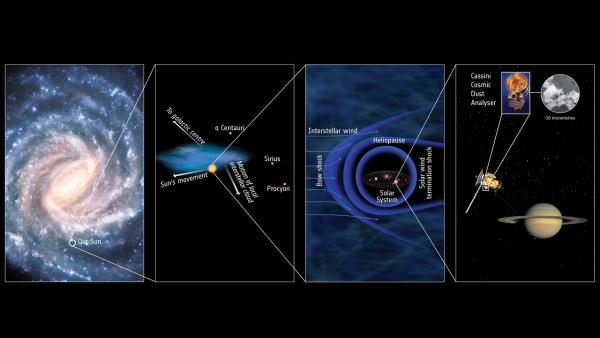Interstellar dust intercepted at Saturn
14 April 2016
The international Cassini spacecraft has detected the faint but distinct signature of dust coming from outside our Solar System.
 |
| Interstellar dust at Saturn. Credits: ESA; dust grain inset: NASA/JPL; Saturn image: NASA/JPL/Space Science Institute |
Cassini has been flying around the Saturnian system for 12 years, studying the giant planet and its rings and satellites. It has also found millions of ice-rich dust grains with its Cosmic Dust Analyser, the vast majority of which are from icy satellite Enceladus and which make up one of Saturn's outer rings.
Amongst the grains detected, 36 stick out from the crowd – and scientists conclude they came from beyond our Solar System.
Alien dust in the Solar System is not entirely unexpected. In the 1990s, the ESA/NASA Ulysses mission made the first in-situ discovery of interstellar dust, later confirmed by NASA's Galileo spacecraft.
The dust was traced back to the local interstellar cloud: an almost empty bubble of gas and dust we are travelling through with a distinct direction and speed.
"From that discovery, we always hoped we would be able detect these interstellar interlopers at Saturn with Cassini: we knew that if we looked in the right direction, we should find them," says Nicolas Altobelli, ESA's Cassini Project Scientist and lead author of the study reporting the results in Science.
"And indeed, on average, we have captured a few per year, travelling at high speed and on a specific path quite different to that of the usual icy grains we collect around Saturn."
The tiny dust grains were speeding through at over 72 000 km/h, fast enough to avoid being trapped inside the Solar System by Saturn's – or even the Sun's – gravity.
Importantly, unlike Ulysses and Galileo, Cassini analysed the composition of the dust for the first time, showing them to be made of a very specific mixture of minerals, not ice.
They all had a surprisingly similar chemical make-up, containing major rock-forming elements like magnesium, silicon, iron and calcium in average cosmic proportions. Conversely, more reactive elements like sulphur and carbon were found to be less abundant compared to the average.
"Cosmic dust is produced when stars die, but with the vast range of types of stars in the Universe we naturally expected to encounter a huge range of dust types over the long period of our study," says Frank Postberg, co-author on the paper and co-investigator of Cassini's dust analyser, of the University of Heidelberg.
"Surprisingly, the grains we've detected aren't old, pristine and compositionally diverse like the stardust grains we find in ancient meteorites," says Mario Trieloff, a co-author also at the University of Heidelberg. "They have apparently been made rather uniform through some repetitive processing in the interstellar medium."
The team speculate that dust in a star-forming region could be destroyed and recondense multiple times as the shockwaves from dying stars passed through, before the resulting similar grains ended up streaming towards our Solar System.
"The long duration of the Cassini mission has enabled us to use it like a micrometeorite observatory, providing us privileged access to the contribution of dust from outside our Solar System that could not have been obtained in any other way," adds Nicolas.
Notes for Editors
"Flux and composition of interstellar dust at Saturn from Cassini's Cosmic Dust Analyzer," by N. Altobelli et al., is published in Science.
The Cassini-Huygens mission is a cooperative project of NASA, ESA and the Italian Space Agency. JPL, a division of the California Institute of Technology in Pasadena, manages the mission for NASA's Science Mission Directorate in Washington.
The Cosmic Dust Analyser is supported by the German Aerospace Center (DLR); the instrument is managed by the University of Stuttgart, Germany.
For more information, please contact:
Nicolas Altobelli
ESA Cassini-Huygens Project Scientist
Tel: +34 91 813 1201
Email: nicolas.altobelli![]() esa.int
esa.int
Frank Postberg
Institut für Geowissenschaften, University of Heidelberg, Germany
Email: Frank.Postberg![]() geow.uni-heidelberg.de
geow.uni-heidelberg.de
Mario Trieloff
Institut für Geowissenschaften, University of Heidelberg, Germany
Email: Mario.Trieloff![]() geow.uni-heidelberg.de
geow.uni-heidelberg.de
Markus Bauer
ESA Science Communication Officer
Tel: +31 71 565 6799
Mob: +31 61 594 3 954
Email: markus.bauer![]() esa.int
esa.int


